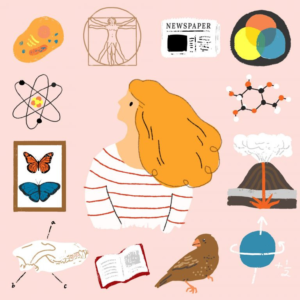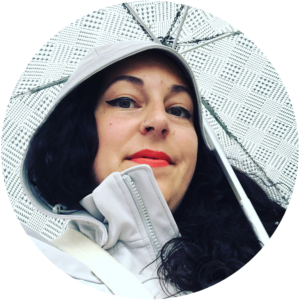Exploring the Intersection of Science and Art
“There are many ways to marry scientific ways of working with artistic practice and it is often more seamless that you may think,” says Samantha Jones, PhD Candidate in the Department of Geography at the University of Calgary.
Her scientific research focuses on inorganic carbon cycling in a connected lake–river–coastal ocean system in Iqaluktuuttiaq, Cambridge Bay, NU. Her artistic work typically takes shape through poetry, and science finds its way into her writing in different forms.
Her poem “Ocean Acidification” explains a process and its context in the midst of the climate emergency while simulating ocean acidification via the arrangement of the words and blank space on the page. First published in Watch Your Head, it was developed into a multimedia clip with science and policy partners and included in the Virtual Ocean Pavilion at COP26. Other examples of her science-poetry are published in GeoHumanities and Arctic.
“We can use art together with our science to amplify results and to reflect on our research from a different perspective."
That different perspective is what drove the Science-Art Symbiosis series, developed by Jones for the Ocean Decade Community of Practice. It included a science-art workbook, inspiration session, and upcoming showcase.
The Science-Art Showcase is part of MEOPAR’s Annual Network Meeting. This “science as art” showcase will take shape in the Annual Networks Meeting’s virtual venue, in its own museum-like room. It includes traditional and non-traditional mediums, such as creative writing pieces, videos, sculpture, “3D art” with standing quilting and beadwork, photography, paintings, and more. It will also include a keynote feature from Geneviève Dupéré, who will present her work-in-progress “From River to Stage,” featuring écH2osystème, a documentary-type performing arts project.
-
Flip through the Science-Art Symbiosis Workbook
-
Watch the Professional Inspiration Session recording
-
Learn more about the MEOPAR Ocean Decade Community of Practice here.
-
Register for MEOPAR’s Annual Network Meeting to explore the Science-Art Showcase. Learn More.

Illustration by Rebecca Michaels-Walker

Samantha Jones introduces some of her work:
“The poem “Ocean Acidification” explains a process and its context in the midst of the climate emergency while simulating ocean acidification via the arrangement of the words and blank space on the page.”
“Poems like “Studying the freshet” and “Red Phalarope” transport you to Freshwater Creek (Iqaluktuuttiaq [Cambridge Bay], Nunavut), the field site central to my research. These pieces immerse you in the field experience as well as showcase some of the seasonal variations and changes associated with the carbon cycles and the local environment in general.”
Samantha Jones’s Invitation to the Science-Art Showcase
“The artists and works in this space challenge and question us. Navya Vikraman Nair quickens the pulse in “Fisheries: Save it to Cherish or Leave it to Perish,” which asks, “What’s going on?” Nair’s “Born to Fish, Forced to Shift: Vulnerabilities of Small-Scale Fisheries in Chilika Lagoon, India” takes us to the heart of the lagoon’s social-ecological changes. Cécile Tang challenges us with “REGENERATION,” asking “Aren’t we all the same?” while emphasizing water as an essential building block of the body.
“There is representation from all three oceans bordering Canada—the Atlantic, the Pacific, and the Arctic—as well as projects that speak to oceans around the globe. Dave Riddell’s hypnotizing electronic music, “Last Days of the Pacific,” undulates with the tides, or perhaps a heartbeat. Danielle Nowosad’s beaded “Mysis relicta, with DNA barcode border” plays with scale and depicts the glacial lake organism bordered with a pattern dictated by data. On the east coast of Canada, Carley Mullally’s “Beach Towel,” a textile assembled from washed up lobster bands, and Jane Affleck’s “Fiona Photo-graphs” explore the entanglement of people and the environment and repurpose to convey present state and ecological grief.
“Ana Carolina Esteves Dias presents a “visual memory” in “Small-scale Fisheries in Colours,” and unapologetically expresses the intention to reflect the self in the work through colour choices. Cailin Correia gifts us with movement in “An Artful Conversation,” a meandering film that envelopes us in dialogue between people amidst the sounds and signals from the surrounding environment.” — Samantha Jones


